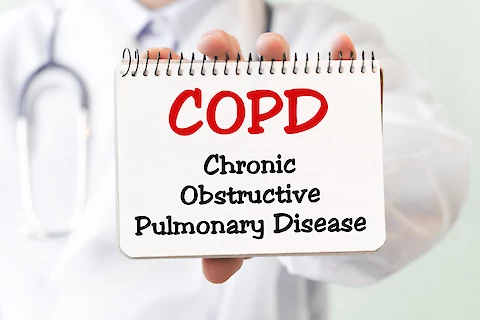Chronic Obstructive Pulmonary Disease (COPD) is a chronic lung disease characterized by persistent respiratory symptoms and airflow limitation. Managing COPD involves medication, lifestyle changes, and notably, exercise. While exercise cannot reverse COPD, but exercise for COPD can improve physical stamina, reduce symptoms, and enhance overall quality of life. Exercise can help manage breathlessness, one of the major symptoms of COPD. It includes two main types: breathing exercises, which focus on techniques to optimize oxygen intake and ease breathlessness, and physical activities, which strengthen the body, improve cardiovascular health, and increase endurance. However, exercising with COPD should always be done under medical supervision, following safety guidelines.
Breathing Exercises for COPD

Breathing exercises play a crucial role in managing Chronic Obstructive Pulmonary Disease (COPD), helping to enhance oxygen intake, control breathlessness, and promote lung expansion.
1. Pursed-lip Breathing: Controlling Breathlessness
One effective breathing exercise for COPD is pursed-lip breathing. This technique involves inhaling slowly through the nose, then exhaling gently with the lips pursed as if blowing out a candle. The exhale should ideally be twice as long as the inhale. This method slows down breathing, helping to prevent rapid, shallow breaths that can heighten feelings of breathlessness. It also helps to keep airways open longer, making it easier to breathe and enhancing oxygen exchange in the lungs. Practicing pursed-lip breathing during periods of rest can prepare individuals to use this technique effectively during physical activity or when experiencing COPD symptoms.
2. Diaphragmatic Breathing: Maximizing Oxygen Intake
The diaphragm is the primary breathing muscle, but COPD can interfere with its optimal functioning. Diaphragmatic breathing is a technique that can help to retrain this muscle, maximizing oxygen intake. To practice this, one can lie on their back or sit comfortably, place one hand on the chest and the other on the stomach, and take slow, deep breaths. The goal is to make the hand on the stomach rise as the diaphragm pushes down, maximizing the space for the lungs to expand. Over time, this can help to improve oxygen intake and reduce breathlessness.
3. Deep Breathing: Relaxation and Lung Expansion
Deep breathing is a straightforward technique that can have a significant impact on managing COPD. It promotes full oxygen exchange and helps to clear out stale air trapped in the lungs, a common problem in COPD. Deep breathing involves inhaling deeply, holding the breath for a few seconds, and then exhaling slowly. Performing this exercise regularly can not only assist in relaxing the body and reducing stress but also aid in promoting lung health by encouraging full lung expansion.
Breathing exercises, when practiced regularly and correctly, can play a pivotal role in managing COPD symptoms and improving overall lung function. However, it’s important to always consult with a healthcare provider or respiratory therapist before starting any new breathing exercises.
Safe Physical Activities for COPD

Physical activities can significantly improve the quality of life for those with Chronic Obstructive Pulmonary Disease (COPD). By strengthening the body, improving cardiovascular health, and boosting lung function, exercises can help manage COPD symptoms.
1. Walking: A Gentle, Effective Exercise for COPD Patients
Walking is an excellent low-impact exercise for COPD. It improves cardiovascular health, builds stamina, and can be done at a pace comfortable for each person. Regular walking, even for short periods, can lead to improved endurance, less breathlessness over time, and an overall sense of well-being.
2. Cycling: Low Impact Exercise for Better Lung Function
Stationary or outdoor cycling can be beneficial for those with COPD. It’s a low-impact activity that strengthens the heart, lungs, and lower body muscles. Cycling at a moderate pace can help improve oxygen usage in the body, making breathing easier over time. It’s always crucial to start slowly and gradually increase duration and intensity based on individual capacity.
3. Strength Training: Building Muscle Strength and Endurance
Strength training can help individuals with COPD by improving muscle strength, boosting metabolism, and enhancing overall endurance. This can involve lightweight lifting or resistance band exercises that work different muscle groups. Regular strength training can make daily activities easier and reduce the risk of COPD exacerbations.
4. Tai Chi: Harmonizing Mind, Body, and Breath
Tai Chi, an ancient Chinese martial art, involves gentle, flowing movements synchronized with deep, controlled breathing. For individuals with COPD, Tai Chi can improve balance, lower stress levels, and enhance breath control. Its low-intensity, slow-paced movements are well-suited for those with limited lung function.
5. Water Aerobics: Low-Impact Activity in a Breath-Friendly Environment
Water aerobics, performed in the chest-deep water of a swimming pool, offers a combination of cardiovascular workout and strength training with the breath-friendly benefits of a humid environment. The buoyancy of water reduces stress on joints, making it an ideal exercise for COPD Patients.
Related: Effects of Exercise of Chronic Diseases.
Pre-Exercise Tips for COPD Patients

1. Consult a Healthcare Provider: Before starting any exercise regimen, individuals with COPD should consult their healthcare provider or respiratory therapist. They can provide guidelines on safe exercises, determine the appropriate intensity level, and discuss how to manage any potential COPD flare-ups during activity.
2. Prepare your Inhaler: If you have a prescribed inhaler, ensure it’s within easy reach during your workouts. Your doctor may recommend using it before beginning exercise to help prevent shortness of breath.
3. Start Slow: COPD patients should start slow and gradually build up the intensity and duration of their exercises. Overexertion can lead to breathlessness and fatigue.
4. Hydrate: Stay well-hydrated. Dehydration can lead to thicker mucus in the lungs, which can exacerbate COPD symptoms.
5. Warm-Up and Cool Down: Begin each workout with a warm-up to prepare your body for exercise and end with a cool down to gradually lower your heart rate. Both steps are important to prevent undue strain on the lungs and heart.
Precautions to Take While Exercising with COPD
1. Monitor your Breath: While some breathlessness during exercise is expected, it’s crucial to avoid extreme shortness of breath. Use the “talk test” to check your breath control: you should be able to speak complete sentences while exercising. If not, lower your intensity.
2. Avoid Exposure to Irritants: Ensure your exercise environment is free of dust, smoke, pollen, and cold air, which can trigger COPD symptoms. Indoor exercise may be more suitable during cold weather or poor air quality days.
3. Rest as Needed: If you become overly fatigued or breathless, take a break. It’s essential to listen to your body and adjust your workout accordingly.
4. Maintain Proper Form: Ensure you are performing exercises correctly to avoid injury and maximize benefits.
5. Consistent Check-ins: Regularly consult with your healthcare provider to update your exercise routine based on changes in your health status.
Conclusion
Incorporating exercise into your COPD management plan can significantly improve your overall well-being. Breathing exercises can enhance lung function, while physical activities strengthen your body and increase endurance. It’s essential to remember that every COPD patient’s condition is unique. Thus, the type, intensity, and duration of exercise should be tailored to individual capacities and should be done under medical supervision. With patience, persistence, and appropriate precautions, you can experience the benefits of exercise, including reduced breathlessness, better daily functioning, and an improved quality of life. Embrace exercise as a vital part of your COPD management and journey towards better health.


